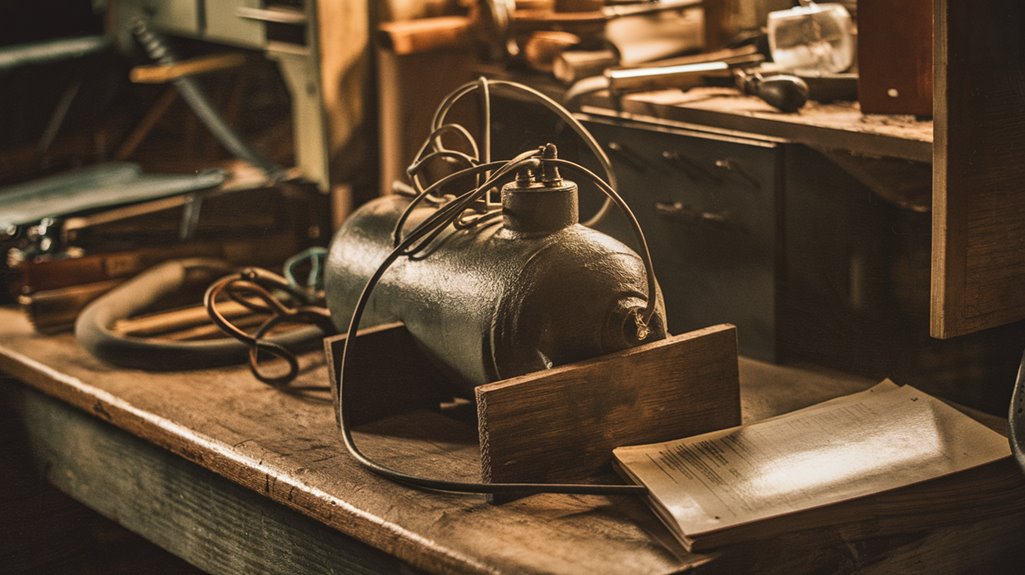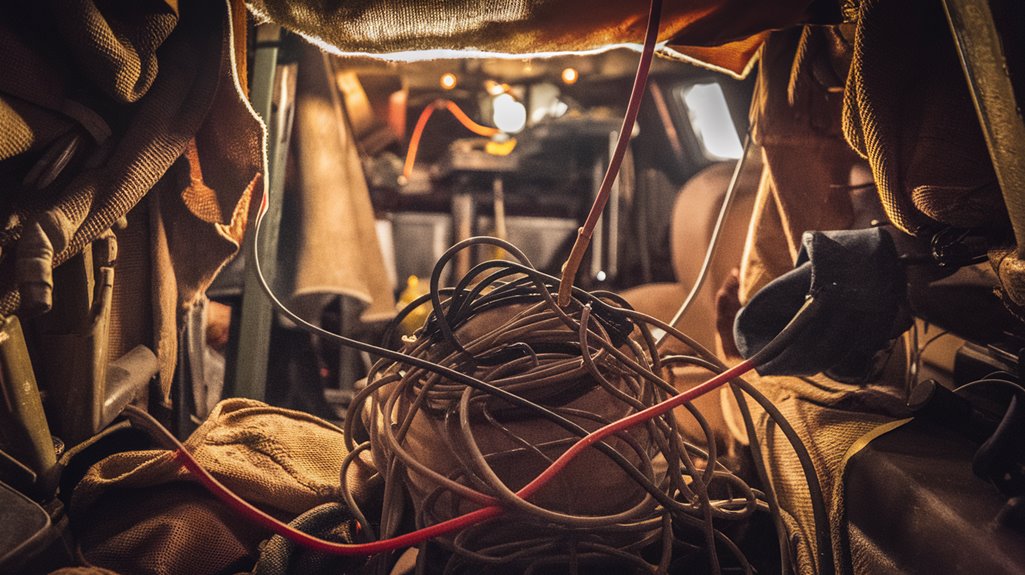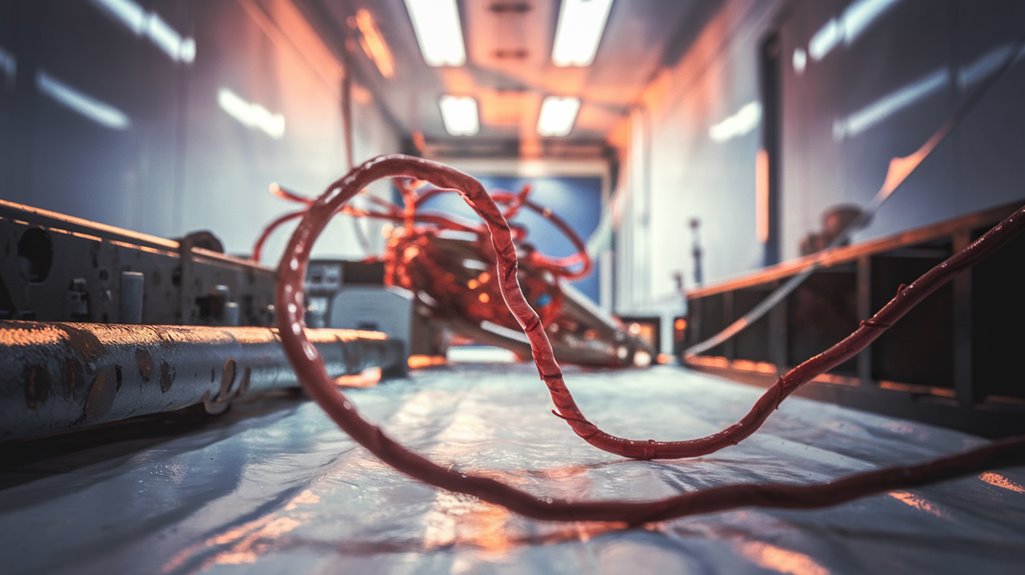The Red Wire Myth: Why Cutting It Might Not Defuse the Bomb
You've seen it in movies, heard it in stories, and maybe even joked about it with friends: just cut the red wire to save the day. While Hollywood has popularized this oversimplified solution to bomb disposal, you're about to discover why this dangerous myth could cost lives rather than save them. From sophisticated anti-tampering mechanisms to deliberately misleading color schemes, modern explosive devices aren't playing by the traditional rules. What you don't know about real bomb disposal might surprise you.
The Origins of Bomb Disposal: Beyond Hollywood Fiction

While Hollywood often depicts bomb disposal as a dramatic choice between cutting the red or blue wire, the actual origins of professional bomb disposal trace back to 1875 when Sir Vivian Dering Majendie established the first civilian bomb squad.
You'll find that these historical milestones began with Majendie's groundbreaking work in framing the Explosives Act and developing remote handling methods for dangerous devices.
His early innovations proved essential during the Fenian Dynamite Campaign of 1881-85, where he successfully defused numerous threats, including a sophisticated clockwork bomb at Victoria Station in 1884. The squad pioneered methods that avoided cutting wires, instead utilizing safer disarming techniques.
By World War I, bomb disposal had evolved into a formal practice, with dedicated British Ordnance Examiners handling unexploded "duds" from mass-produced munitions.
The Royal Engineers created 25 specialized Bomb Disposal Companies between 1940 and 1941 to address the increasing threats during World War II.
These developments laid the foundation for modern explosive ordnance disposal techniques.
Debunking the Red Wire Strategy
When it comes to myth debunking, experts emphasize that relying on wire color is a dangerous misconception that can lead to fatal consequences.
You'll find that modern explosive devices often contain multiple wires intentionally designed to deceive disposal attempts.
Similar to the critical finding that metrics over quality drives harmful research culture, bombers frequently mislabel or alter wire colors specifically to thwart traditional disposal methods.
The evolution of disposal techniques now relies heavily on shotgun techniques and specialized equipment to safely disable explosive devices from a distance.
Instead of focusing on wire color, bomb disposal experts rely on sophisticated techniques like portable X-ray imaging, disruption tools, and remote-controlled robots to safely neutralize threats.
Historical incidents, including a tragic IRA case where mistaking detonating cord for a simple wire led to disaster, serve as stark reminders that modern bomb disposal requires expertise beyond simplistic color-based solutions.
Modern Disposal Techniques: What Really Works
Modern explosive disposal bears little resemblance to the wire-cutting scenes popularized by Hollywood. Instead, you'll find EOD technicians relying on remote techniques that keep them safely away from dangerous devices.
They use advanced remotely operated vehicles and water disruptors to neutralize threats without direct contact. As circumstances and data evolve, EOD teams must demonstrate rapid adaptability to address emerging threats.
Specialized equipment plays an essential role in today's disposal operations. You'll see bomb disposal vehicles equipped with containment chambers, while robots like the Dragon Runner conduct reconnaissance. The recently developed enhancement in infrared depth perception helps EOD robots navigate three-dimensional environments with greater precision.
High-tech tools such as portable X-ray systems and infrared sensors help technicians understand a device's internal structure before taking action.
These methods, combined with extensive training and international cooperation, allow EOD teams to handle increasingly complex threats while maintaining maximum safety.
It's a sophisticated approach that's constantly evolving to meet new challenges.
The Hidden Dangers of Direct Interaction
Direct interaction with explosive devices presents life-threatening risks that demand immediate respect and caution. When you encounter suspected explosives, your immediate response can mean the difference between life and death.
Direct interaction with these devices can trigger devastating consequences, including overpressure damage to your organs, severe fragmentation injuries, and life-altering thermal burns. Military munitions are designed to destroy and can remain lethal for decades after manufacturing.
You'll face heightened risks from secondary devices specifically designed to target first responders. That's why it's essential to remember that only trained EOD personnel should handle explosive hazards.
If you discover a suspicious device, follow the 3Rs: Recognize the threat, Retreat from the area, and Report it to authorities.
Don't let curiosity override safety – even seemingly inactive devices can detonate without warning, causing catastrophic injuries that extend beyond physical trauma.
Advanced Technology in Explosive Ordnance Disposal

As explosive threats become increasingly sophisticated, technological breakthroughs in EOD operations have revolutionized how we detect, analyze, and neutralize dangerous devices. Through AI integration, you'll find systems that can process vast amounts of sensor data to identify explosive threats with remarkable accuracy, while reducing risks to human operators. Similar to how the Smyth Report release helped manage public information about atomic weapons, modern EOD teams now emphasize controlled information sharing about emerging threats.
The robotics advancement in EOD has been equally impressive. You'll see autonomous systems and ROVs tackling dangerous tasks in both land and underwater environments, keeping you and your team safely distant from potential hazards. Companies like Oceanbotics are leading the way in providing specialized ROV solutions for these critical operations.
These robots, combined with advanced sensors and AI-driven analysis, deliver thorough situational awareness that you wouldn't achieve through traditional methods. Ground-penetrating radar and chemical sensors now provide you with faster, more precise detection capabilities, making EOD operations considerably safer and more effective.
Safety-First Approaches: Real-World Solutions
While advanced technology enhances EOD capabilities, implementing robust safety protocols remains the foundation of successful operations. When you're responding to a potential explosive threat, scene safety must be your top priority.
You'll need to conduct preliminary evaluations, establish a secure perimeter, and guarantee proper protective equipment is in place before proceeding with any investigation. Teams rely on radiographic intelligence gathering before approaching suspicious devices, ensuring maximum safety during assessment. Due to the complex nature of nuclear devices, internal secrecy debates often complicate response procedures.











